
Temple Newsam, is a Tudor-Jacobean house in Leeds, West Yorkshire, England, with grounds landscaped by Capability Brown.

Sheffield Manor Lodge, also known as Sheffield Manor or locally as Manor Castle, is a lodge built about 1516 in what then was a large deer park southeast of Sheffield, South Yorkshire, England, to provide a country retreat and further accommodate George Talbot, the 4th Earl of Shrewsbury, and his large family. The remnant of this estate is now known as Norfolk Park. The housing estate of Manor is named after Sheffield Manor Lodge.
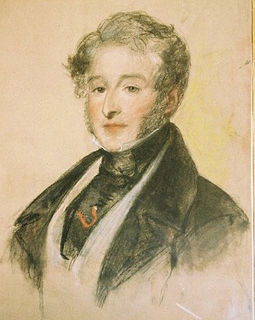
Baron Dinevor, of Dinevor in the County of Carmarthen, is a title in the Peerage of Great Britain. It was created on 17 October 1780 for William Talbot, 1st Earl Talbot, with remainder to his daughter, Lady Cecil, wife of George Rice, a member of a prominent Welsh family. On Lord Talbot's death the earldom became extinct because he left no sons to succeed to it, while the barony of Talbot also held by him was inherited by his nephew. The barony of Dynevor passed according to the special remainder to his daughter, the second holder of the title. In 1787 Lady Dynevor assumed by Royal licence the surname of de Cardonnel in lieu of Rice.

Sherborne Castle is a 16th-century Tudor mansion southeast of Sherborne in Dorset, England, within the parish of Castleton. It stands in a 1,200-acre (490 ha) park which formed a small part of the 15,000-acre (61 km2) Digby estate.

Weston Park is a country house in Weston-under-Lizard, Staffordshire, England, set in more than 1,000 acres (400 ha) of park landscaped by Capability Brown. The park is located 10 miles (16 km) north-west of Wolverhampton, and 8 miles (13 km) north-east of Telford, close to the border with Shropshire. The 17th-century Hall is a Grade I listed building and several other features of the estate, such as the Orangery and the Stable block, are separately listed as Grade II.

George Talbot Rice, 3rd Baron Dynevor (Dinefwr) was a British peer and politician. He was the son of Cecil de Cardonnel, 2nd Baroness Dynevor and George Rice. He was educated at Westminster School and matriculated at Christ Church, Oxford on 1 February 1783, where he was awarded a Master of Arts degree on 30 May 1786.

Remenham is a village and civil parish on the Berkshire bank of the River Thames opposite Henley-on-Thames in southern England.

Pishiobury, sometimes spelled Pishobury, was a manor and estate in medieval Sawbridgeworth, Hertfordshire. Its denomination as "Pishiobury" only emerged in the mid to late 19th century.

Hampton Poyle is a village in the Cherwell valley in Oxfordshire, England, about 1 mile (1.6 km) northeast of Kidlington and about 5 miles (8 km) north of the centre of Oxford. It is part of the civil parish of Hampton Gay and Poyle.

Great Barrington is a village in the Cotswold district of Gloucestershire, England. It lies in the north bank of the River Windrush, 3 miles (4.8 km) west of the town of Burford.

Beckett Hall is a country house at Shrivenham in the English county of Oxfordshire. The present house dates from 1831.

Hensol Castle is a castellated mansion in the gothic architecture style dating from the late 17th century or early 18th century, now a wedding and conference venue for The Vale Resort. It is located north of Clawdd Coch and Tredodridge in the community of Pendoylan in the Vale of Glamorgan, Wales. It is a Grade 1 listed building.

Worksop Manor is a Grade I listed 18th-century country house in Bassetlaw, Nottinghamshire. It stands in one of the four contiguous estates in the Dukeries area of Nottinghamshire. Traditionally, the Lord of the Manor of Worksop may assist a British monarch at his or her coronation by providing a glove and putting it on the monarch's right hand and supporting his or her right arm. Worksop Manor was the seat of the ancient Lords of Worksop.

Alfreton Hall is a country house in Alfreton, Derbyshire. It was at the heart of local social and industrial history in the county. The history of the estate goes back to Norman times, but by the 17th century it was owned by the Morewood family, who were linked to local industry, mainly in coal mining.

Lytham Hall is an 18th-century Georgian country house in Lytham, Lancashire, 1 mile (1.6 km) from the centre of the town, in 78 acres (32 ha) of wooded parkland. It is recorded in the National Heritage List for England as a designated Grade I listed building, the only one in the Borough of Fylde.
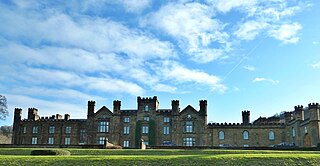
Wilton Castle is an early 19th-century mansion, built on the site of a medieval castle, now converted into luxury residential apartments, situated at Wilton, in Redcar and Cleveland, North Yorkshire, England. It is a Grade II listed building.
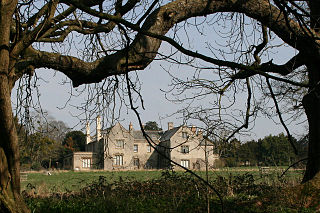
Poundisford Park north of Pitminster, Somerset, England is an English country house that typifies progressive house-building on the part of the West Country gentry in the mid-16th century. The main house was built for William Hill around 1550 and has been designated as a Grade I listed building.
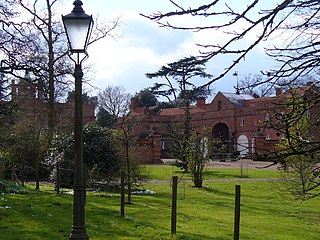
Ockham Park is a seventeenth century English country house in Ockham, Surrey.
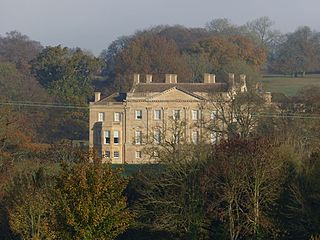
Edmund Bray (1686–1725) of Barrington Park, Gloucestershire was a British politician who sat in the English House of Commons from 1701 to 1708 and in the British House of Commons from 1720 to 1722.
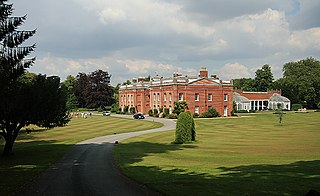
Avington House is a 16th-century English country house which stands in Avington Park in the Itchen Valley near Winchester, Hampshire. It is a Grade I listed building.




















